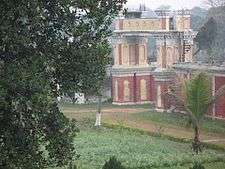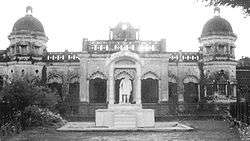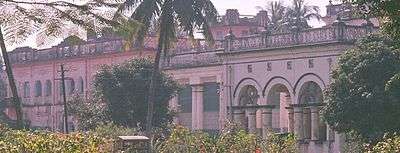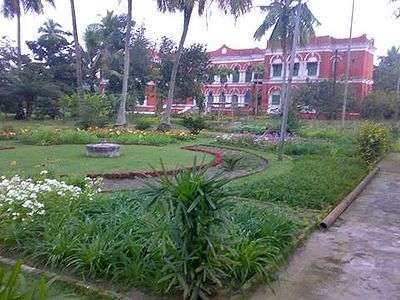Banaili


Banaili estate in Bihar was one of the largest estates in India. It covered parts of regions that are currently located in four of India's current states, namely, Bihar, Jharkhand, West Bengal and Orissa.
The name of the estate derives from a village Banaili in the then Purnia district of Bihar.
The main centres of residences of Rajas of Banaili are Banaili, Ramnagar, Champanagar, Srinagar, Garh Banaili, and Sultanganj. Bhagalpur was the centre from where administration of the estate was carried out.

One of the centres of Banaili Raj located in Sultanganj is believed to have ancient historical or mythical association. The Krishnagarh palace built by Kumar Krishnanand Singh on Sultanganj is in the Karnagarh area, which is believed to be place where the Castle of King Karna of Mahabharata was located.
Raja Bahadur Dular Singh Chowdhry
Though the roots of the family can be traced to 11th - 12 th century as done ably by Girijanand Sinha in his book, Banaili - Roots to Raj, the family achieved its famed eminence only in the 19th century during the reign of Raja Bahadur Dular Singh Chowdhry. It was Raja Dular Singh who fixed the family residence at Banaili and gave the family its current name. He was an enterprising Raja and added to the family's wealth using the opportunities afforded by the Permanent Settlement implemented by Lord Charles Cornwallis, 1st Marquess Cornwallis in the then state of Bengal. He received the title of Raja Bahadur from the British Government for his services during the Anglo-Nepalese War. Raja Dular Singh died in 1821.
Raja Bahadur Bedanand Sinha
The expansion of the Banaili Raj continued under his able son, Raja Bahadur Bedanand Sinha. He was born in 1778 and succeeded his father at an advanced age of 43. He died in 1851. He is credited for the creation of much of the family's wealth which he did during a period of 30 years while he was at the helm of affairs of the estate. He received his title of Raja Bahadur with his succession in continuation of the title given to his father. He continued his residence in the village of Banaili, and expanded the palace there during his tenure. He extended the Banaili Raj through acquisitions of estates that were located in the-then districts of Munger, Bhagalpur, Santhal Paraganas and Purnea. With these acquisitions, the size of the Banaili estate expanded around four to five times during his reign. He was interested in wrestling and sponsored many wrestling competitions in which he also took part. He also wrote a book on Ayurveda named Bedanand Vinod.
Raja Bahadur Lilanand Sinha
His son, Raja Bahadur Lilanand Sinha, maintained the family's eminence and was famous in the entire region for his piety and benevolence. Many stories of his charity and kindness still abound in the Mithila region. He was also responsible for shifting the family's residence from Banaili which had then become a hotbed for malaria to Ramnagar in Purnia district. He again shifted his residence from Ramnagar to Champanagar, 22 km from Purnia town in Bihar leaving his eldest son, Raja Bahadur Padmanand Singh to continue to stay in Ramnagar. The deorhi in Ramnagar still survives but is no longer in the state it once was.
Raja Bahadur Kalanand Sinha

Raja Lilanand Singh had two sons from his fourth wife - Raja Kalanand Sinha and Raja Bahadur Kirtyanand Sinha (Raja Padmanand Singh being the eldest born of his second wife). The former shifted after the death of his father to a new Deorhi he built in Garh Banaili Purnia district, which was famous for its beauty and perhaps the most exquisite of the residences built by the Banaili family. The deorhi has not survived with his successors bringing the edifice down after India's independence.
Raja Kalanand Singh is listed in the official directory of the Coronation Durbar of 1911 as one of those attending the ceremonies.
Raja Bahadur Kirtyanand Sinha

The more prominent and better educated son of Raja Lilanand Singh was Raja Bahadur Kirtyanand Singh. He was a Bachelor of Arts from Allahabad University and was famous for his many pursuits - shikaar (hunting), Polo - as well for the role he played in the contemporary public life. He wrote three books - Purnea, a Shikarland; Shikar in Hills and Jungles; and Homeopathic Practice .
He made a contribution to the establishment of T.N.B College in Bhagalpur which was in need of funds having been established in 1880s. The Raja made a contribution of "60 acres of land and 600,000 of rupees in Cash for the construction of building and other developmental work". For this contribution and other acts of charity, he was awarded the title of "Raja" in June 1914. On 9 July 1917, he was appointed as a government nominee to the Champaran Agrarian Committee which had been set up to resolve the issue of indigo planters in Champaran following the famous Champaran Satyagraha Champaran and Kheda Satyagraha by Mahatma Gandhi.[1] In this committee, he worked with Mahatma Gandhi, and for his work in the Committee he was awarded the title of "Raja Bahadur" in 1919.
On the request and appeal made by Sri Braj Mohan Thakur, Raja Bahadur Krityanand Singh along with Raja Tank Nath Choudhary created separately a chair of Maithili in Calcutta University . This went a long way in advancing maithili as a language.
He was one of the founders of the Bank of Bihar, which survives even now as the Bihar State Cooperative Bank Limited. He also started a Banaili Iron and Steel Works in Sitarampur in Asansol, referred to in the book on Indian Economy written by eminent historian Amiya Kumar Bagchi and also in a book "Bihar" published by the National Book Trust. This venture, unfortunately, as the noted historian Amiya Kumar Bagchi observes, did not survive the "Great Depression".
The Raja, along with Maharaja of Darbhanga Maharaja of Darbhanga#cite note-56, hosted the first flight expedition over the Mount Everest in 1933 Maharaja of Darbhanga#cite note-56. "The Raja of Banaili, a cheery personality, who had shot over hundred tigers, offered us his fleet of motor-cars, remarking that, if possible, he would like to retain one or two of his own. He had seventeen. He seemed astonished, as if at an unusual display of moderation, when only three cars and a lorry were required." (Quoted in Everest - The Mountaineering History by Walt Unsworth from First Over Everest, The Houston-Mount Everest Expedition 1993 by Air Commodore PFM Fellowes et al.).
The Raja is credited for issuing the first official state invitation to the great maestro duo of Ustad Salamat & Nazakat Ali Khan of the Sham Chaurasia gharana in 1934. Ustad Salamat Ali Khan was then 11 years old and Nazakat Ali Khan 13 years . They were invited to perform at the Dussehra festival in Champanagar Deorhi (Palace) and the royal host liked their rendition of Malkauns so much that he would not let them leave Champanagr . The duo stayed under the patronage of the Raja for a few months, and some believe that their Basant Bahar composition "Des des ki thi jung dushman sab har gaye" is in the praise of the Raja.

Another great musician, Ustad Altaf Hussain Khan of Khurja, served as a court musician in the darbar of the Raja. Ustad Altaf Hussain Khan also gave music lessons to Raja's eldest son, Rajkumar Shyamanand Sinha .
Raja Bahadur Kirtyanand Sinha stayed in public life until his death in 1938. His place of residence remained the Champanagar Deorhi in Purnia inherited from his father. This Deorhi has remained the most enduring of the deorhis of Banaili Raj and to this day is inhabited by the descendants of the Raja. there is a hathi named sanat he also belongs to the same family
Rajkumar Shyamanand Sinha

Raja Bahadur Kirtyanand Sinha had six sons and three daughters. But, the most prominent of his six sons was Rajkumar Shyamanand Sinha. He had many pursuits such as Shikar and in particular Billiards, where he won Bihar Championship in Billiards many times.
However, he is remembered mainly for his extraordinary talent in hindustani classical music. He was not only blessed with a gifted voice but had tremendous natural ability to bring "pran" in ragas that made them come alive in a most pleasing manner. He belonged to the old school of Hindustani classical music and believed in maintaining purity and spontaneity in performance. His rendition of ragas was an absolute delight and mesmerised the listeners transferring the singer's sense of ecstasy to the audience in a way that very few have managed to this day.
Along with his singing prowess, his legendary voice made a tremendous mark on one and all who came in touch with him. This included some great contemporary singers like Kesarbai Kerkar. Kesarbai, who was visiting Champanagar for a performance was so enthused by his rendition of "Dwarikanath Sharan Me Teri" that she insisted politely that he teach the song to her. She even expressed her readiness to make him her Guru for this song.
Rajkumar Shyamanand Sinha believed that singing was the highest form of devotion and this reflected in his performances. President Zakir Hussain, once when he was Governor of Bihar, was so moved by his performance that he embraced him stating that the Rajkumar's singing was like praying to the almighty. Gajendra narayan Singh in his book has written that "Kumar Shyamanand Singh of Banaili estate had such expertise in singing that many great singers including Kesarbai were convinced about his prowess in singing.In case you cannot believe this please ask Pandit Jasraj. After listening to Bandishes from Kumar Saheb, Jasraj was moved to tears and lamented that alas! if he could have such ability himself"(free translation of Hindi text). Vilayat Hussain Khan in his book "Sangeetangyon ke Sansmaran" has written: "There is no better connoisseur and cognoscente of music in Bihar than Kumar Shyamanand Singh"(free translation of Hindi text).
Though Rajkumar Shyamanand Sinha learned from many eminent names, his acknowledged Guru was the legendary Vishmadev Chattopadyay of Kolkata, who had learnt music from Badal Khan and Faiyaz Khan of Agra Gharana. Shyamanand Sinha learnt from Vishmadev Chattopadyay from 1936-39. After Vishmadev Chattopadyay left for Aurobindo Ashram in Pondicherry, Rajkumar Shyamanand Sinha continued his music lessons, at the advice of his guru, from Bachu Khan Sahib of Agra (from 1940-1962-63). Other eminent singers from whom he obtained music lessons were Muzzaffar Khan, Mubarak Ali Khan, Bholanath Bhatt, Kedarjee, Altaf Hussain Khan of Khurja, Mahaveer Mullick, and Jaduveer Mullick.
He shunned music as a profession and never sought public recognition. He gave very few public performances, most of his performances being during impromptu baithaks at his residence in Chamapanagar in the presence of his admirers and disciples. Despite his reluctance for public acknowledgement, his followers conferred him with the title of Sangeet Bhaskar and Sangeet Sudhakar for his mastery in classical singing.
He was also a great patron of classical music. He was one of the chief patrons of the All India Music Conference and presented the convocation address at the 11th All India Music Conference of The Prayag Sangit Samiti at Allahabadh on 19 December 1948. He used his great wealth to open the purse strings of patronage to many maestros of Hindustani Classical Music of his time at his residence in Champanagar, turning it into a place of learning and development of classical music. Salamat Ali Khan, Altaf Hussain Khan of Khurja and Bachu Khan Sahib and many others were provided residence and patronage in Champanagar. He also invited many great maestros for performances, among them were "Aftab -e- Maushiqi" Faiyaz Khan, D. V. Paluskar, Kesarbai Kerkar, Sawai Gandharva, Vilayat Hussain Khan, Altaf Hussain Khan of Khurja, Pandit Jasraj, Narayanrao Vyas, Basavaraj Rajguru, and Salamat Ali Khan and Nazakat Ali Khan.
Unfortunately, the few professional recordings done by All India Radio in the latter part of his life are untraceable. Only a few amateur recordings of his singing are available with his family members and friends. These are rare treasures and absolute delight for the senses. They have somehow survived his idiosyncratic hatred for recording largely due to the efforts of his disciple nephew Kumar Girijanand Singh. Unfortunately, the excellence of his singing tradition did not survive his death though his influence stayed with some of his disciples who are striving hard to keep the flame burning in Purnia.
Some other references to Banaili Raj on the web
| Wikimedia Commons has media related to Banaili. |
- Reference to Forest of Munger owned by Raja of Banaili
- Reference to history of Banaili Raj
- Another reference in All India Reporter 1926
- Reference to Raja Kirtyanand Singh in the Minutes of the Champaran Committee of Gandhi
- Reference to a case involving Rani Prabhavati Devi in Supreme Court of India
- Reference to famous Hindi novelist Saratchandra having worked in the Banaili estate
- Reference to Ustad Vishmadev Chattopadyay as a Guru of Rajkumar Shyamanand Sinha